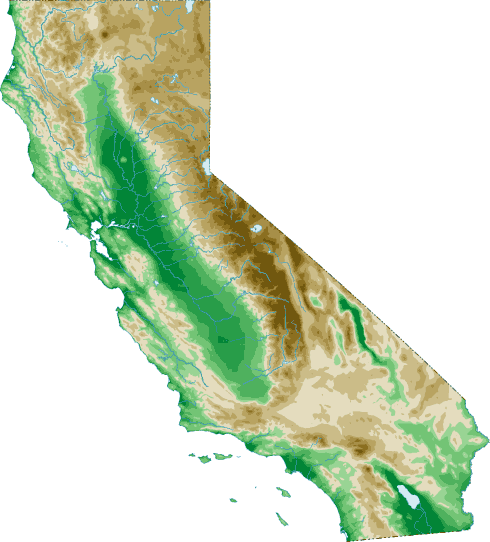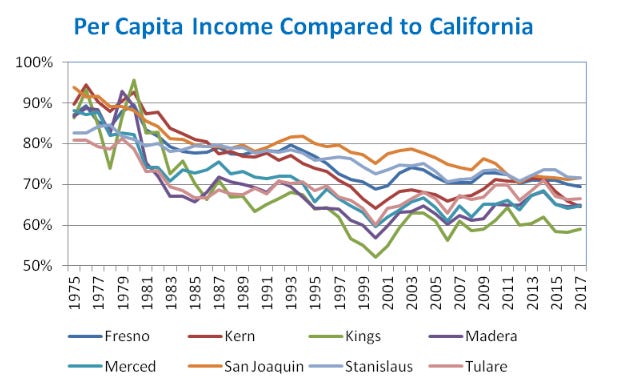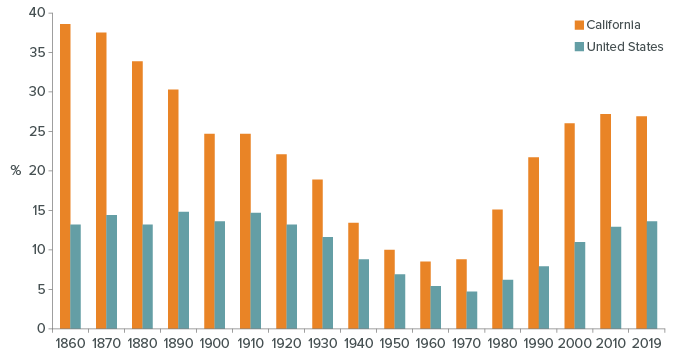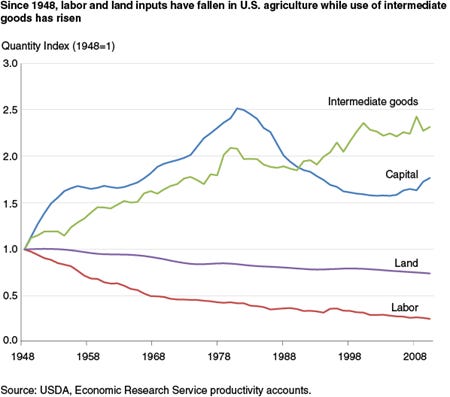Why Is The Central Valley So Bad?
I.
Here’s a topographic map of California (source):
You might notice it has a big valley in the center. This is called “The Central Valley”. Sometimes it also gets called the San Joaquin Valley in the south, or the the Sacramento Valley in the north.
The Central Valley is mostly farms - a little piece of the Midwest in the middle of California. If the Midwest is flyover country, the Central Valley is drive-through country, with most Californians experiencing it only on their way between LA and SF.
Most, myself included, drive through as fast as possible. With a few provisional exceptions - Sacramento, Davis, some areas further north - the Central Valley is terrible. It’s not just the temperatures, which can reach 110°F (43°C) in the summer. Or the air pollution, which by all accounts is at crisis level. Or the smell, which I assume is fertilizer or cattle-related. It’s the cities and people and the whole situation. A short drive through is enough to notice poverty, decay, and homeless camps worse even than the rest of California.
But I didn’t realize how bad it was until reading this piece on the San Joaquin River. It claims that if the Central Valley were its own state, it would be the poorest in America, even worse than Mississippi.
This was kind of shocking. I always think of Mississippi as bad because of a history of racial violence, racial segregation, and getting burned down during the Civil War. But the Central Valley has none of those things, plus it has extremely fertile farmland, plus it’s in one of the richest states of the country and should at least get good subsidies and infrastructure. How did it get so bad?
II.
First of all, is this claim true?
I can’t find official per capita income statistics for the Central Valley, separate from the rest of California, but you can find all the individual counties here. When you look at the ones in the Central Valley, you get a median per capita income of $21,729 (this is binned by counties, which might confuse things, but by good luck there are as many people in counties above the median-income county as below it, so probably not by very much). This is indeed lower than Mississippi’s per capita income of $25,444, although if you look by household or family income, the Central Valley does better again.
| [](https://substackcdn.com/image/fetch/f_auto,q_auto:good,fl_progressive:steep/https%3A%2F%2Fbucketeer-e05bbc84-baa3-437e-9518-adb32be77984.s3.amazonaws.com%2Fpublic%2Fimages%2F3c613382-ec3d-421a-b13b-5fee75594959_1280x720.jpeg)I looked for photos of the Central Valley to illustrate this article, but none of them were quite as I remember it. This one from Sacramento Bee is the closest I could find. But imagine it through a layer of haze, and also you can’t see well because you are in the process of dying from heatstroke. |
Of large Central Valley cities, Sacramento has a median income of $33,565 (but it’s the state capital, which inflates it with politicians and lobbyists), Fresno of $25,738, and Bakersfield of $30,144. Compare to Mississippi, where the state capital of Jackson has $23,714, and numbers 2 and 3 cities Gulfport and Southhaven have $25,074 and $34,237. Overall Missisippi comes out worse here, and none of these seem horrible compared to eg Phoenix with $31,821. Given these numbers (from Google), urban salaries in the Central Valley don’t seem so bad. But when instead I look directly at this list of 280 US metropolitan areas by per capita income, numbers are much lower. Bakersfield at $15,760 is 260th/280, Fresno is 267th, and only Sacramento does okay at 22nd. Mississippi cities come in at 146, 202, and 251. Maybe the difference is because Google’s data is city proper and the list is metro area?
Still, it seems fair to say that the Central Valley is at least somewhat in the same league as Mississippi, even though exactly who outscores whom is inconsistent.
III.
What do the people who live in the Valley think went wrong?
_What The Hell Is Wrong With California’s Central Valley?, _starting around 9:30, interviews a local conservative realtor (most people in the Valley are conservative; I haven’t found a liberal equivalent).
He says that the farms in the Central Valley used to be manned by migrant workers, who would come from Mexico, work for a season, then go back to Mexico and live off their earnings for the rest of the year. Later, policies shifted to welcoming them and granting them citizenship, so many of them came over and brought their families. But around the same time there was a drought, the farm industry crashed, the remaining farms mechanized, all the immigrants were left without work, they got on welfare, and they weren’t able to get off of it.
He doesn’t say exactly when this happened, but he says times were good when he was a child, and he looks like he’s in his 30s or 40s. So if he’s 35 and things started going bad when he was 10, that would mean he thinks things started going bad around 1995 to 2000.
Here’s a story in the LA Times from 1999, which talks about how things are starting to get bad. It admits that Californians like to poke fun at the Central Valley, but it seems to be just that - poking fun - and not freaking out about poverty and dysfunction the way articles about the Valley do now. But it ends by saying that things are getting worse:
To be honest, living in the Central Valley takes some getting used to, especially if you’re from the coast. It’s an acquired taste.
Oppressive heat in summer. Depressing tule fog in winter. Sure, fall and spring are OK. But where aren’t they?
First-rate culture is scarce. The state capital doesn’t even have a symphony.
One of the attractions–it’s almost a local joke–is the ability to get away, particularly from Sacramento. It’s 90 minutes to San Francisco in one direction, or skiing in another; two hours-plus to the ocean or Tahoe […]
Still, earthquakes aren’t a menace to most people. And it doesn’t take long before you begin to appreciate certain benefits–indeed, to understand that some Central Valley burgs, especially the capital, are among California’s best kept secrets. Or, at least, they have been.
Continuing:
When I moved here nearly 40 years ago–the first of three times–summer skies were blue and the stars bright. Fishing was easy in the rivers and pheasant hunting was 10 minutes from town–in fact, where I now live.
All this good life, however, has been changing.
Sacramento is now the sixth smoggiest area in the country. A gloomy, beige pall greets motorists as they descend from the Sierra. Even worse is the San Joaquin Valley, from Stockton to Bakersfield. It’s rated the nation’s fourth smoggiest region […]
And this brings us to the root problem: a population explosion, fed notably by commuters spilling over the Grapevine from L.A. into Bakersfield, and from the Bay Area into the northern San Joaquin Valley, turning farms into houses and freeways into parking lots. In Sacramento, high-tech industry is generating jobs and sprawl.
Up and down the valley, people without job skills are having babies and going on welfare. Many are immigrants from Mexico and Southeast Asia. “The population is growing at a faster pace than the economy,” notes Dan Whitehurst, a former Fresno mayor who is running again. “Livability is becoming more of an issue. But the biggest issue still is jobs.”
That’s because, aside from Sacramento, the Central Valley has not cashed in on California’s economic boom. Unemployment in the San Joaquin Valley is roughly double the state average.
It’s smoggy. Traffic’s getting worse. Farms are disappearing. There aren’t enough jobs. And, says pollster Mark Baldassare, people are “myopic” about their plight.
It finishes:
“We have a huge problem. ‘No way L.A.’ has been our slogan. But if we build nonstop houses, we’ll be worse than L.A. because we’ll have destroyed our [farm] economic base. . . . There’s no regional leadership. More state officials need to decide this area matters and poke their heads up out of the fog.”
The fog and the smog. If not, one day there’ll be no getting used to the place.
This is a weird article. It seems to confirm that things used to be better - nobody would call the Central Valley “the good life” now. But its concerns are smog, sprawl, and decreasing share of agriculture. These seem like the problems of somewhere that’s growing - local NIMBYs complaining that too many people want to move in. Today the problem is more that everyone in the Central Valley wants to leave. The piece sort of touches on poverty - “people without job skills are having babies and going on welfare” and “the population is growing at a faster pace than the economy” - but it’s still a weird emphasis, and one that makes me think of this as supporting the “problems were starting in the 90s” view.
But by 2012, things were clearly very bad - here’s an article about how Census Shows Central Valley Areas Among Poorest In Nation. It says:
Experts say the poverty problem in the nation’s agricultural powerhouse is deeply ingrained. The most important barrier is the valley’s lack of economic diversity. There are simply too few good nonagricultural jobs around and jobs in agriculture tend to be low-wage ones — except for those who run agribusinesses.
“It’s a pretty ag-heavy region, so the inequality of wages and the opportunity to earn better wages is really skewed,” said Caroline Farrell, executive director of the Delano-based Center on Race, Poverty & the Environment. “If you own a farm, you’re apt to earn more wealth, while if you’re a farmworker, don’t earn very much.”
The valley has not been able to bring or retain many new companies partly because it lacks a qualified workforce, said Atonio Avalos, associate professor of economics at Fresno State University.
“We have an issue of skills mismatch,” Avalos said. “Companies may be offering jobs, but the skills of people in the valley are not ones they are looking for.”
Students who want to get a college degree face many barriers, he said, and public funding for education is being slashed. Those who do graduate leave to find jobs elsewhere.
The valley also doesn’t offer attractive amenities and has serious problems such as air pollution that have gone unaddressed.
“If you’re a doctor or engineer, there are other places where you can make good money and live in better conditions,” Avalos said. “Many people don’t come here or leave because of the high incidence of asthma and other respiratory problems.”
This sounds like things were already pretty bad in 2012, maybe bad enough that they must have been getting worse for longer than 10 or 15 years, I don’t know.
IV.
What do the data say?
Here are some economic time series. I couldn’t find any good long-term ones; the least bad one comes from this unsourced report:
Here it looks like things got worse from 1975 - 1985, and then depending on county there was a slower-to-imperceptible decline thereafter.
FRED only has data since 1989, but agrees that things haven’t gotten worse since then. Here’s unemployment:
Is this just because people got discouraged (or on welfare) and stopped seeking employment, and so stopped showing up in the statistics? Here’s a graph of Total Employed Persons:
In 1990, 303,000 people were employed out of a population of 354,000. In 2022, 430,000 people were employed out of a population of 542,000. So labor participation rate went from 86% to 79%. But national labor force participation decreased by about the same amount during that time, so I don’t think we should overemphasize that.
And here are some other graphs I found useful:
Fresno housing prices:
Racial demographics:
Central Valley cities like Fresno and Bakersfield aren’t really more Hispanic than other parts of California or Arizona, so if immigration or racial issues played a part it must have been more complicated than just numbers.
Number of immigrants in California over time:
Factors of productivity in agriculture:
V.
So why is the Central Valley so bad?
It’s an agricultural region, but lots of places are agricultural. It got lots of immigrants, but no more than many other places. It’s polluted - but so was LA, and LA rebounded.
This is just a weak guess, but I think it starts with their crops. The Midwest grows mostly corn and wheat. The Central Valley is more fruits, vegetables, and nuts. Corn and wheat are easier to harvest, so middle-class farmers can own the farm and buy a mechanical harvester or something. Fruits, vegetables, and nuts benefit from intensive manual picking, so farm owners hire outside labor.
According to Carolina Demography:
There are about 3 million farmworkers in the United States: about two million are family farmworkers and another one million are hired farmworkers…nationally, about three-fourths of hired farmworkers are foreign-born; most (69%) were born in Mexico; 6% were born in Central America; and 1% were born in another country.
Given that these are mostly Mexican immigrants, we’re probably not talking about people who are hired to grow corn in Kansas. I think plausibly the majority of US hired farmworkers live in California’s Central Valley. This makes it a sort of plantation agriculture system, which naturally tends towards landowners taking all the gains and workers ending up as an underclass. In the mid-20th century, the local plantation underclass was made of Okies (cf. The Grapes of Wrath). In the later 20th century, many immigrants moved in, lowering wages. Although immigrants don’t usually lower wages, this is because there are usually lots of industries for people to branch out into, but the Central Valley only has agriculture. Also, agribusinesses were becoming better at mechanizing their operations. Although technology doesn’t usually lower wages, again, this requires lots of diverse industries, and the Central Valley only had agriculture. All of this corresponds to the 1975-1985 period on the graphs where wages were going down.
But it sounded from some of the testimonials above like the Central Valley didn’t become truly miserable until the late 90s. I’m not sure why this is. It could be the immigrants switching from being migrant laborers to raising families, and those families were impacted by poverty and inequality in a way the original migrants weren’t. It could be worsening drug problems as new drugs get invented and go down in price.
(I’m not sure if NIMBYism and rising house prices also played a part. House prices do seem to have risen, a lot, but I was under the impression that building things in the Central Valley was easy and most of a house’s price there is construction rather than land. I’m not sure why house prices would have gone up so much since 1990 if this were true, though.)
Other things that the articles I read emphasized:
-
There’s a severe drought in the Central Valley right now. This is probably partly climate change, partly bad luck, and partly California diverting water to hydrate growing coastal cities. This has made everything worse (but then why isn’t that reflected in worsening economic statistics?)
-
Everyone who can get out of the Central Valley does. Getting out of the Central Valley is very easy because the rest of California is right there. This creates a brain drain and a vicious cycle
-
Drugs and crime have gotten worse. This is probably partly a reaction to increasing poverty, and partly improvements in drug technology and supply chains.
-
California has a high minimum wage and lots of progressive regulations, which are maybe not a great match for a desperately poor area whose entire economy is based on devastating the environment in various ways. This is actually a pretty recent change; California was a red state in presidential elections until 1992.
-
Sometimes well-off residents of California coastal cities get houses in the Central Valley and commute. It’s about 2 hours from LA to Bakersfield, or 1.5 from Stockton to San Francisco, so it’s not worth it for most people. But Central Valley houses cost between 25% and 50% the cost of coastal houses, so I guess it’s worth it for some. I don’t know whether this is good (because these people bring money in and create jobs) or bad (because these people bid up land values).
Overall I’m still not sure what went so wrong or when. But it’s humbling and a little scary to realize how much poverty is so close to me, in such a rich state.







